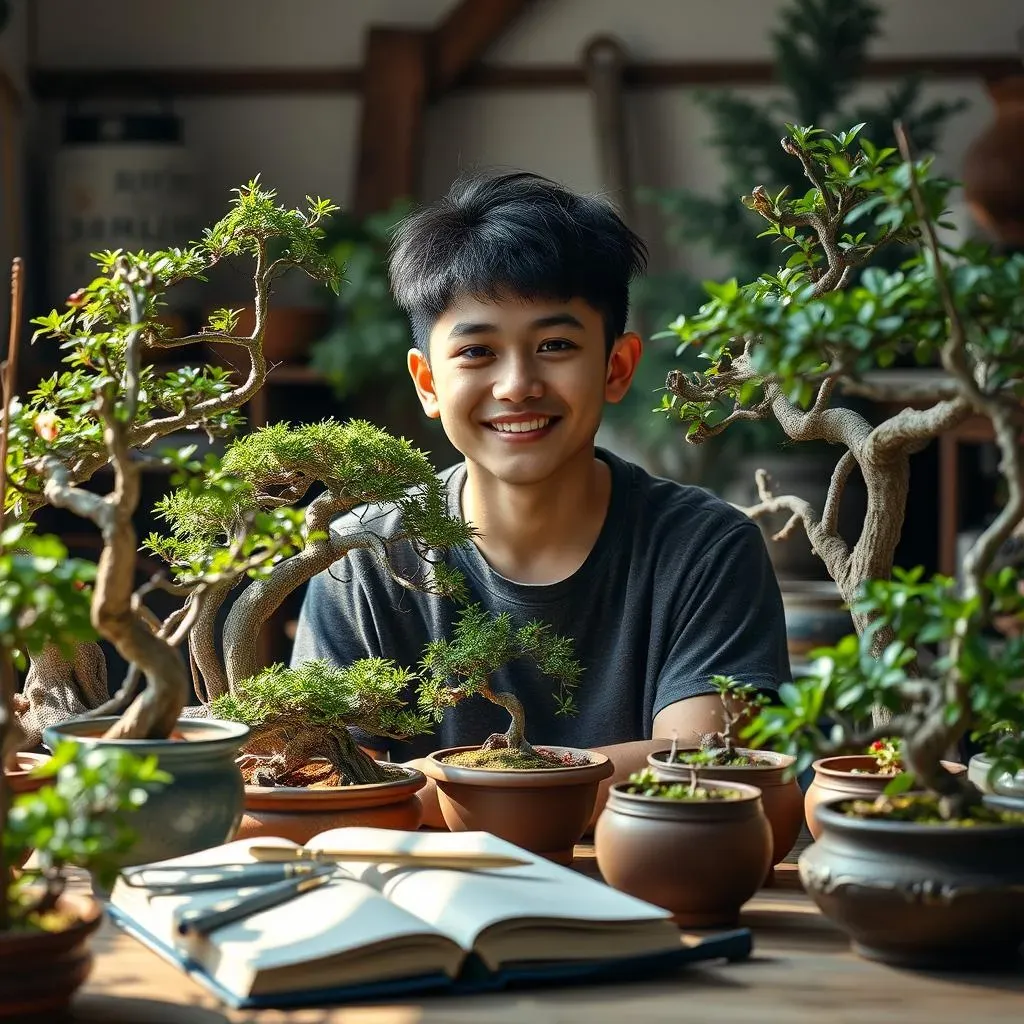Table of Contents
Ever looked at a tiny tree in a pot and thought, "Wow, that's cool, but how?" You're not alone! The art of bonsai, especially for 盆栽 初心者 (bonsai beginners), can seem a bit mysterious. But trust me, it's not magic; it's just a mix of patience and a few simple techniques. This article is your friendly guide to demystifying the world of bonsai. We'll start with the absolute basics, like what even makes a tree a bonsai, and then we will move to selecting your first tree that is not going to die on you. After that, we will check out the essential tools you'll need and how to use them without accidentally giving your little tree a bad haircut. Lastly, we'll cover the daily care stuff, so your bonsai not only lives but actually thrives. Think of this as your bonsai cheat sheet – no green thumb required, just a desire to grow something small but mighty. So, let's get started and see what all the fuss is about with these miniature trees!
Understanding the Basics of Bonsai for Beginners
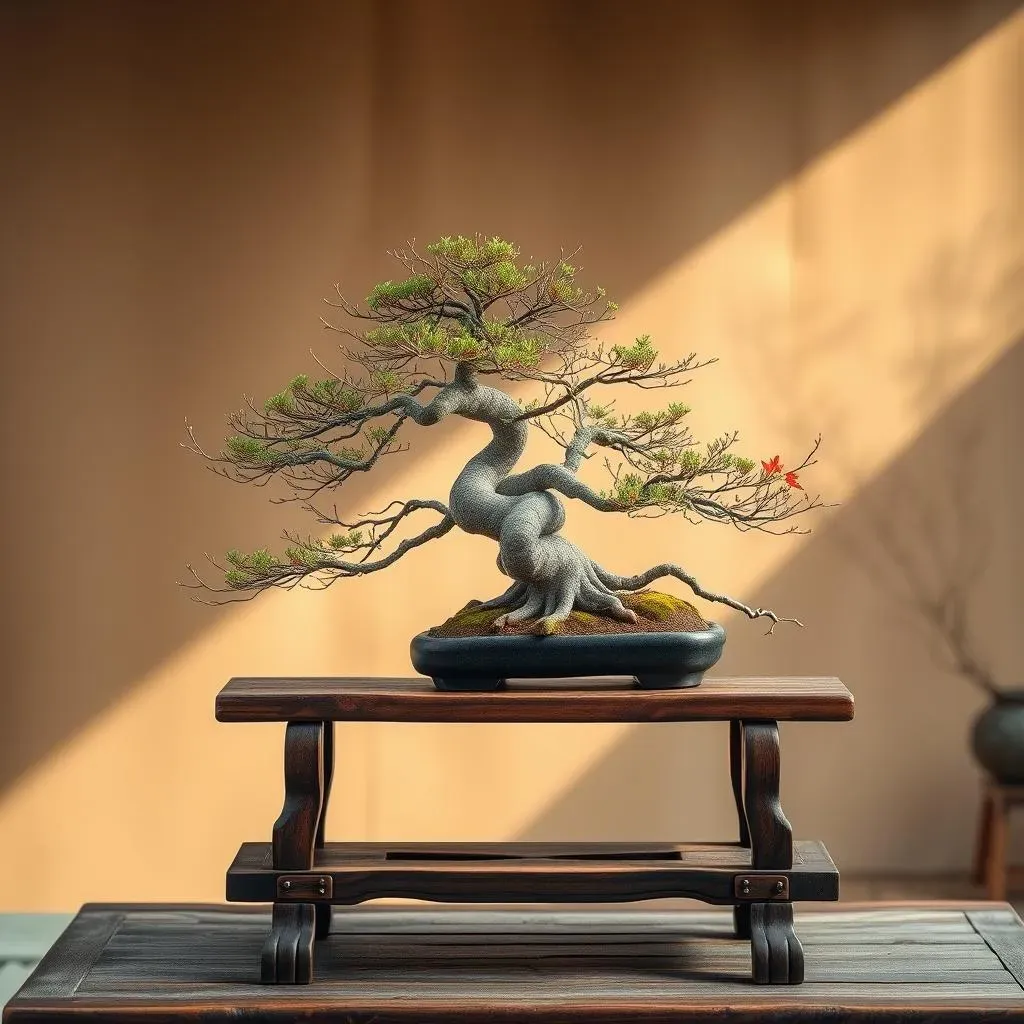
Understanding the Basics of Bonsai for Beginners
What Exactly IS a Bonsai Anyway?
Okay, so you see these tiny trees, and they're, like, super cute, right? But a bonsai isn't just any small tree in a pot. It's a living piece of art, carefully shaped and cultivated to look like a mature tree in miniature. Think of it like a living sculpture. It's not about making the tree suffer; it’s about guiding its growth through specific techniques to achieve an aesthetic balance. It’s a practice that blends horticulture with a touch of artistry, and that’s why it's so fascinating.
Bonsai originated in China, but it was the Japanese who really took it to the next level. They developed the styles and techniques we know today. It's been around for centuries, and each tree is a representation of time, care, and the artist's vision. So, when you get into bonsai, you're not just growing a tree; you're connecting with a long and fascinating history. It's pretty amazing when you think about it, right?
The Key Principles of Bonsai
Now, let's talk about what makes a bonsai, well, a bonsai. It's not just about keeping a tree small. There are key principles that bonsai artists follow. First, there's the idea of scale; the tree and the pot should look like a balanced composition. The tree should look like a tree, just a tiny version. Second, there's the principle of asymmetry and naturalness. Bonsai aren't supposed to look perfect, they should mimic nature. Third, you've got to consider the trunk, branches, and roots, they should all be visible and carefully arranged. It's not just about letting it grow wild. It’s like giving a tree a very specific role in a small stage play.
Then there's the aspect of constant care and shaping. Bonsai is not a set it and forget it kind of hobby. It needs regular watering, fertilizing, and pruning. You're constantly working with the tree, guiding its growth, and making sure it stays healthy and beautiful. It's a long-term commitment, but it’s also incredibly rewarding. It's like having a living pet, but instead of barking, it just grows slowly and beautifully. You get to watch it change and evolve over time. And that's pretty cool, if you ask me.
Bonsai Principle | Description |
|---|---|
Scale | The tree and pot should be proportionate. |
Asymmetry | Balance through natural, imperfect forms. |
Visible Structure | Trunk, branches, and roots are all part of the design. |
Constant Care | Regular watering, fertilizing, and pruning are essential. |
Choosing Your First Bonsai: BeginnerFriendly Trees
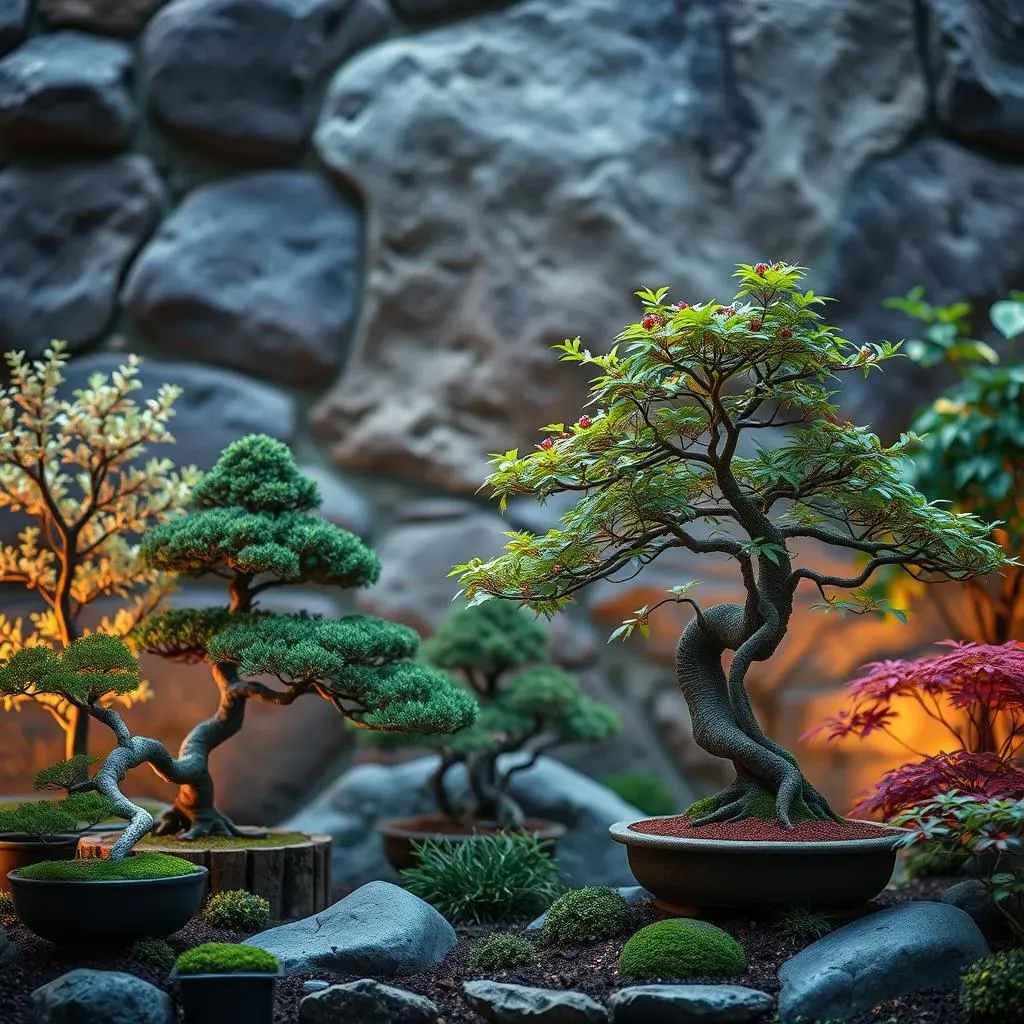
Choosing Your First Bonsai: BeginnerFriendly Trees
Why Picking the Right Tree Matters
Okay, so you're ready to jump into the bonsai world? Awesome! But hold your horses, not all trees are created equal, especially when you're just starting out. Choosing the right tree is like picking the right character in a video game – some are way easier to handle than others. Some trees are super picky about their environment, and if you get it wrong, they'll just up and die on you, and that's no fun for anyone. For beginners, it's best to choose trees that are a bit more forgiving. We want something that's going to give you a chance to learn the ropes without getting discouraged by constant failures. Think of it like starting with a simple recipe before you tackle a complicated souffle.
The goal here is to find a tree that's hardy, adaptable, and can handle a few beginner mistakes. You're learning, and that’s totally okay. You don't need to start with some exotic, temperamental species that will have you pulling your hair out. You want a tree that can deal with some inconsistent watering, maybe a little too much sun, or a little too little. This way, you can actually focus on learning the techniques and enjoying the process, instead of constantly worrying about whether your tree is about to throw a tantrum. And let's be real, we've all been there with a needy houseplant, haven't we?
Top Picks for Beginner Bonsai Trees
So, what kind of trees are we talking about? Well, there are a few that are known for being pretty chill and easy to care for. The Chinese Elm is a great choice; it's tough, it grows quickly, and it’s pretty forgiving when it comes to watering. Another good option is the Ficus; these guys are super adaptable and can handle a range of conditions, which makes them great for beginners who are still figuring things out. They are like the golden retriever of the bonsai world: loyal, friendly, and not too demanding. And if you're looking for something a bit different, the Japanese Maple is a good choice. They look amazing, especially in the fall, and they’re reasonably easy to care for. Just remember, you're not choosing a tree for a beauty contest, but a tree that will help you learn the art of bonsai without too much stress.
Now, before you rush out and buy the first cute tree you see, do a little research and make sure it suits your environment. If you live in a place with freezing winters, you'll need to choose a tree that can handle the cold, or be prepared to bring it indoors during the winter. If you live in a hot place you will need to choose a tree that can handle the heat. Always do your homework, it will pay off. Think of it as choosing a pet, you wouldn't get a penguin if you live in the desert, right? Same goes for bonsai, you need to pick a tree that matches your climate and your lifestyle. It’s all about setting yourself up for success, not failure.
Tree Type | Why it's good for beginners | Things to consider |
|---|---|---|
Chinese Elm | Tough, fast-growing, forgiving | Needs good light |
Ficus | Adaptable, handles various conditions | Can be sensitive to cold |
Japanese Maple | Beautiful, relatively easy to care for | Needs protection from harsh elements |
Essential Tools and Techniques for Beginner Bonsai
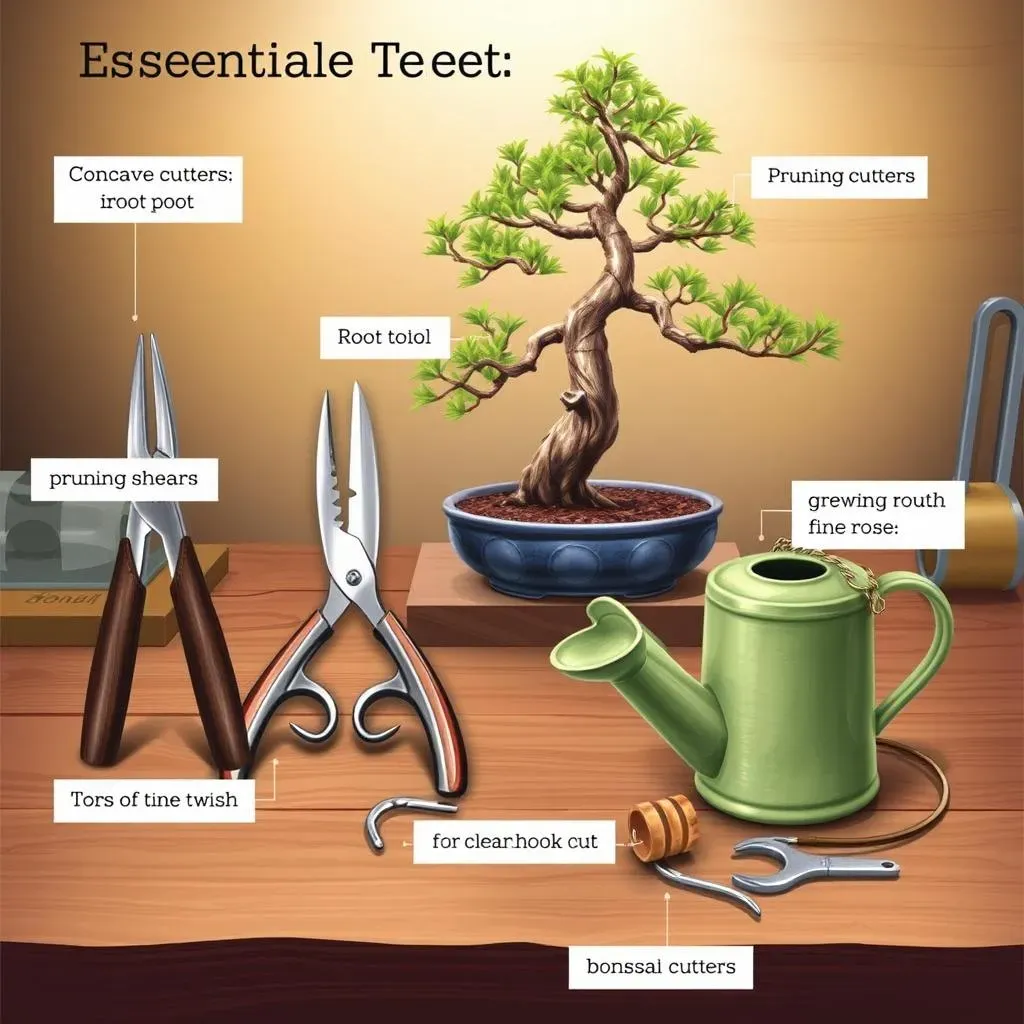
Essential Tools and Techniques for Beginner Bonsai
Must-Have Tools for Your Bonsai Kit
Alright, so you've got your tree picked out, now let's talk tools. You don't need a whole garage full of stuff to start, but a few key items will make your life a whole lot easier. First up, you absolutely need a good pair of concave cutters. These aren't your regular scissors; they're designed to cut branches flush to the trunk, which helps with healing and prevents those ugly stubs. Think of them as the surgeon's scalpel for your bonsai. Then, you'll want some good quality pruning shears for trimming smaller branches and leaves. These are like your bonsai's barber, keeping everything neat and tidy. And don't forget a root hook or a small rake for working with the soil when you're repotting. These aren't just fancy tools; they're essential for keeping your bonsai healthy and looking its best.
Besides those, having a watering can with a fine rose is also a must. It's like giving your tree a gentle shower rather than a firehose blast. You'll also want some wire, usually aluminum or copper, for shaping the branches. Wire is like the training wheels for your tree, helping it grow in the direction you want. And finally, a good soil mix is crucial; it’s like the food your bonsai eats, so you've got to make sure it's the right stuff. You can buy pre-made bonsai soil or mix your own, which is pretty fun once you get the hang of it. These tools are not just about cutting and shaping; they're about caring for your bonsai, and they're essential for success. It's like having the right ingredients when you're baking a cake; without them, it just won't turn out right.
Basic Bonsai Techniques for Beginners
Okay, now that we've got the tools sorted, let's talk about some basic techniques. Pruning is probably the most important thing you'll be doing, and it's not as scary as it sounds. It's all about removing unwanted growth to encourage the tree to grow in a particular way. You'll be snipping off branches that are growing in the wrong direction, or that are too thick or too crowded. It's like giving your tree a haircut, but with a purpose. Wiring is another key technique, and it's how you bend and shape branches. You gently wrap wire around the branch, and then bend it into the desired position. This is how you achieve those cool, artistic shapes you see in bonsai. Don't worry, you're not going to break your tree, just be gentle and patient.
Repotting is another essential part of bonsai care. This is when you remove the tree from its pot, trim the roots, and then replant it in fresh soil. This helps keep the roots healthy and prevents the tree from becoming root-bound. It's like moving your tree to a bigger house when it needs more space. And finally, don't forget about watering and fertilizing. Bonsai need regular watering, but you've got to be careful not to overwater them. It is like giving your tree a drink, not drowning it. Fertilizing is also important, because it gives your tree the nutrients it needs to grow strong and healthy. It's like feeding your tree a balanced meal. These techniques might seem a bit overwhelming at first, but with practice, they'll become second nature, and you will be a bonsai pro in no time!
Tool | Purpose |
|---|---|
Concave Cutters | Cutting branches flush to the trunk. |
Pruning Shears | Trimming smaller branches and leaves. |
Root Hook/Rake | Working with soil during repotting. |
Watering Can with Fine Rose | Gentle watering. |
Wire (Aluminum or Copper) | Shaping branches. |
A Quick Guide to Pruning
Pruning is like giving your bonsai a haircut, but with a specific goal. Always use sharp, clean tools to prevent disease. Start by removing any dead or damaged branches. Next, remove branches that are growing straight up or down. These are usually not ideal for the overall shape. Then, focus on thinning out crowded areas to allow light and air to reach all parts of the tree. Make your cuts close to the trunk or branch to avoid stubs. Prune gradually, rather than all at once. It is better to do multiple small cuts than one big cut. Remember to step back and look at your bonsai from different angles to make sure you're creating the look you want. It is a skill that requires practice, so don't worry if you don't get it perfect the first time, just keep learning, and soon you will be a pruning master.
“The best time to plant a tree was 20 years ago. The second best time is now.” – Chinese Proverb.
Caring for Your Bonsai: Beginner Tips for Success
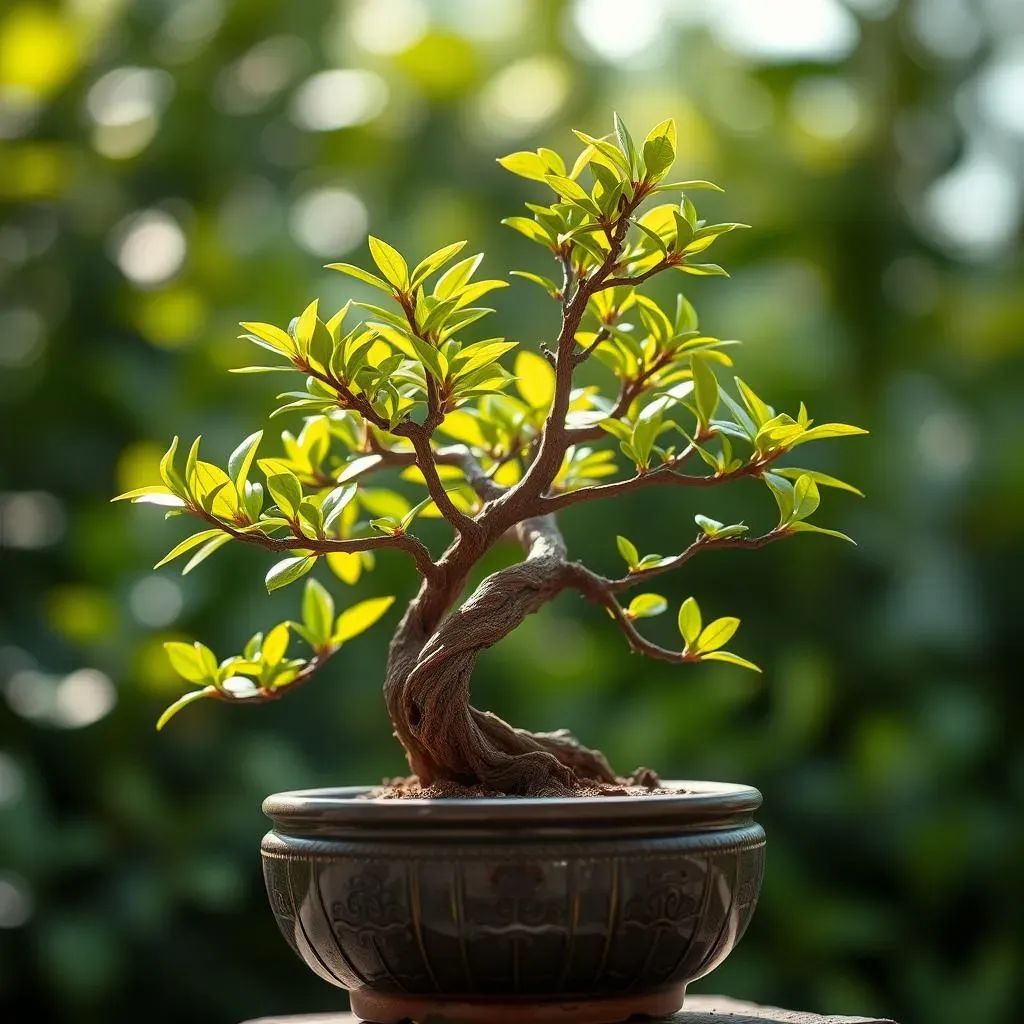
Caring for Your Bonsai: Beginner Tips for Success
The Art of Watering Your Bonsai
Okay, let's chat about watering, which is honestly where most beginners trip up. It's not as simple as just dumping water on your tree and calling it a day. Overwatering is a real bonsai killer, it can lead to root rot, which is basically a death sentence for your little tree. You need to water your bonsai when the topsoil feels dry to the touch, not when you remember it's been a few days. It is like checking if you are thirsty instead of just drinking water every 3 hours, you drink when you are thirsty. When you do water, make sure you soak the soil thoroughly, until water drains out of the bottom of the pot. This ensures that the roots get the hydration they need. Using a watering can with a fine rose helps to distribute the water evenly, and it’s like giving your bonsai a gentle rain shower, rather than a fire hose blast. Remember, less is more when it comes to watering, you don't want to drown your tree, just give it a good drink.
Also, the time of day you water can matter. Watering in the morning is generally best, because it allows the foliage to dry out during the day, which helps prevent fungal diseases. Imagine going to bed with wet hair, and how uncomfortable that is, well, your bonsai feels the same way. You also have to consider the climate and the season. During the hot summer months, you'll probably need to water more often, while in the cooler winter months, you can reduce the watering. It’s all about paying attention to your tree and adjusting your routine accordingly. Think of it like checking on a pet, you wouldn't feed your cat the same amount every day, you would adjust based on its activity level, well, your bonsai is the same. It requires observation and a bit of intuition. It is all about finding the right balance.
Feeding Your Bonsai: Fertilizing 101
Alright, so now that we have watering sorted out, let’s talk about food, or as we call it in the bonsai world, fertilizing. Just like us, bonsai need nutrients to grow, especially since they are living in a small pot. You need to fertilize your bonsai regularly during the growing season. You can use a balanced liquid fertilizer that is specifically formulated for bonsai, or you can use a slow-release fertilizer. Liquid fertilizer is usually applied every two weeks, while slow-release fertilizer can be applied every few months. It's like giving your tree a vitamin boost, but you have to be careful not to overdo it, you do not want to give it too much of a good thing.
When you are fertilizing, always follow the instructions on the fertilizer label, and never use more than recommended. Over-fertilizing can damage the roots and cause the tree to burn. You should also avoid fertilizing your bonsai during the winter months, when it is dormant. It’s like giving a sleeping bear a plate of food, it is not going to eat it. The right kind of fertilizer and the right amount is crucial for keeping your bonsai healthy and vibrant. It’s like giving a car the right kind of fuel, it needs it to run smoothly. You're not just watering your bonsai, you're also feeding it, and that's a crucial part of the care routine.
Aspect of Care | Beginner Tips |
|---|---|
Watering | Water when the topsoil is dry. Soak thoroughly until water drains out. Water in the morning. Adjust with season. |
Fertilizing | Use balanced bonsai fertilizer. Follow label instructions. Fertilize during the growing season. Avoid fertilizing in winter. |
The Importance of Light and Location
Where you put your bonsai is just as crucial as how you water it. Most bonsai trees need plenty of sunlight to thrive, but the exact amount depends on the type of tree you have. If you have an outdoor tree, you should put it somewhere that gets direct sunlight for at least six hours a day. It's like giving your tree a sunbath, it needs that vitamin D. If you have an indoor tree, you should put it near a window that gets plenty of light. You might even need to use a grow light if your home doesn't get enough natural sunlight. You have to make sure your tree is getting the light it needs to photosynthesize and grow. It's like giving your tree a solar panel, it needs it to generate energy.
Besides light, you also need to consider the temperature and humidity. Most bonsai trees don't like extreme temperatures, so you'll need to protect them from frost in the winter and intense heat in the summer. It is like protecting a baby from the elements. You also want to make sure your bonsai is in a place with good air circulation, but not in a drafty area. It’s all about creating a comfortable environment for your tree. If you live in a dry climate, you might need to increase the humidity by placing your bonsai on a tray of pebbles filled with water, or by using a humidifier. It is like giving your tree a spa day, it will enjoy it. The right location is crucial for keeping your bonsai healthy and happy. It is like finding the perfect home for your tree.
Dealing with Common Problems
Even with the best care, you might run into some problems with your bonsai. One common issue is pests, like aphids or spider mites. If you notice any bugs on your tree, you'll need to treat it with an insecticide. It's like calling a pest control company for your tree. Another common problem is diseases, like root rot or fungal infections. If you suspect your tree has a disease, you'll need to treat it with a fungicide. It is like taking your tree to the doctor. But the most common problem is not getting the watering, or light right, so keep an eye on that. Remember that prevention is always better than cure, so always keep an eye on your bonsai.
Also, sometimes you might notice that your bonsai is not growing as well as it should, or that the leaves are turning yellow. This could be a sign that your tree is not getting enough nutrients, or that the soil is not draining properly. Always do some research and try to find what is causing the issue. You might need to adjust your watering or fertilizing routine, or you might need to repot your tree in fresh soil. It’s like being a detective, you need to investigate and find the clues. Bonsai care is a learning process, and even the most experienced bonsai artists run into problems. Don't get discouraged, just learn from your mistakes, and keep on growing. It is like learning to ride a bike, you will fall a few times, but you will eventually get it.
“To plant a garden is to believe in tomorrow.” – Audrey Hepburn
